
by Lori Vande Krol | Sep 1, 2021 | General Productivity, Goals and Priorities, Habits, Task and Project Management, Time Management
Recently on a beautiful Sunday afternoon, I decided to join my husband for a bike ride. We filled the tires and water bottles, put on our helmets, and headed out. I felt a little extra resistance while peddling up the hill out of our neighborhood and thought, “Ok, this is hard. I think I just need to warm up.” As we pedaled on, I continued to feel that the ride was much more difficult than I expected. I couldn’t keep up with my husband – it seemed even when he wasn’t peddling he was going faster than me – and I was already out of breath. Thoughts that were going through my head during this time included: “I thought I was in better shape than this.” “I work out more than him…why can’t I keep up?” “Is biking really that different than my regular workout?” “What is wrong with me?”
After over three miles of this, it was time to turn back for home. We stopped so I could catch my breath and get a drink of water and my husband said, “Are you sure there isn’t something wrong with your bike? Maybe your tires?” I responded that it felt like it was riding fine and I didn’t hear any strange noises or rubbing, but let me get off my bike and check just to be sure. Lo and behold, the front brake was snug against the tire. I had basically been riding with the brakes on! After a few minutes, I figured out the problem, fixed it, and we rode home in about half the time it took us to get there – a much more enjoyable ride.
What does this somewhat embarrassing story have to do with productivity?
How many times in your life are you pushing against some sort of friction without realizing it? What could be made easier and more enjoyable if you stepped back and really analyzed, and addressed the issue? Often, we are so engrossed in day-to-day life, information, and tasks that we fail to really consider what we are doing. It is vital that we regularly take time to review and reset. In his book Essentialism: The Disciplined Pursuit of Less, Greg McKeown asks “Is there a point at which doing less (but thinking more) will actually produce better outcomes?” My response is “yes”! And my sore legs would agree.
Below are three simple steps you can take to minimize or alleviate the friction in your life and career.
1. Take Notice
Pablo Picasso said, “Without great solitude, no serious work is possible.” It is important to take focused time regularly to review your actions. Are they intentional? Do they reflect your priorities? Are you in control or are you letting others define your schedule and tasks? Are there processes, projects, or tasks that could be done more efficiently or effectively? A regular review might include the following questions:
- What is going well for me? How can I continue this?
- What do I not enjoy? What are my challenges? What can I stop doing? What can be made simpler?
- What do I most enjoy? What do I look forward to? How can I do more of this? What might get in the way?
This reflection is much easier to do if you are clear on your vision, priorities, and plan. For more on this, see my June 2021 blog, Mastering Time Management: What To Do Before the To Do List.
2. Identify the Issue
When you take focused time to reflect and review your priorities and related actions, it becomes simpler to identify any issues that are holding you back, getting in your way, or causing unnecessary friction. Maybe it’s a process, tool, or system that isn’t working optimally. Perhaps a colleague, friend, or family member is causing tension or stress. Or maybe it’s the position, company, or career you are in. It may even be a medical issue that has been overlooked resulting in lower productivity, and higher stress and anxiety.
If you are reviewing systems and processes for a company or team, identifying issues can entail a full-blown workflow analysis to find areas for automation, unneeded duplication, or improvements to technology, training, and communication. More often though, it just takes quiet, focused thought or journaling to pinpoint obstacles towards reaching your goals. Identify them and write them down.
3. Create Change
How will you minimize or alleviate the issues you have identified above? Consider any resources needed to support the change as well as your own habits or actions that need to change. What will you do differently going forward to reduce the friction or obstacles keeping you from success and enjoyment? Making a full plan for success is great, but sometimes you’ll need to just start with one small action step. Then, take another and another. Change can be hard, but the increased joy and success will be well worth it. And, you will likely reach your goals much quicker than you would have otherwise.
As my husband and I drove our bikes back into the garage, we found our daughter waiting for us to leave for her soccer game. Since the bike ride took much longer than expected, we were almost late. I realized then how much the friction I was working against for the first half of the ride impacted more than just me. It also caused stress for my daughter and potentially her team and coach if we were late. While I wish I would have stopped to evaluate the situation sooner, the fact that I did eventually stop to (1) take notice, (2) identify the issue with the brakes, and (3) create change by working to fix it, allowed for a much more enjoyable ride home, and we arrived at pre-game warm-up just in time.

by Lori Vande Krol | Jun 25, 2021 | Goals and Priorities, Task and Project Management, Time Management
You are constantly presented with new information, communications, to-dos, and ideas. At any point in time, you have hundreds of options for how you choose to spend that moment. While it may feel good to check things off a to-do list, if you aren’t intentional about what is on your to-do list or in your schedule, as well as the choices you make throughout the day, you are not productively working towards goals but instead just “being active.” This can eventually lead to feeling drained, overwhelmed, directionless, and even a sense of failure.
Oxford Dictionaries defines time management as “the ability to use one’s time effectively or productively, especially at work.” But you are only managing your time effectively if you are spending it on the right things, i.e. those tasks and activities that support your greater vision and goals. This starts with knowing what is important and where you want to go. Then, you can better define your shorter-term goals, ensure your actions relate to and support those goals, and achieve the success and happiness you desire. Let’s break this down.
Step 1: Know What is Important and Where You Want To Go
If you aren’t clear about what is important in your life and work, you will likely be overwhelmed and unsure if you’re using your time in the most optimal way. All of the planners, apps, and products in the world can’t help you if you don’t know your priorities.
In order to create the needed clarity, the first step is to determine your long-term vision for work and life. If this is an exercise you haven’t done before, it can be difficult but eye-opening. Start by setting aside some focused time to write your answers to the following questions:
- What do I love about my life right now? What do I enjoy doing? What am I good at?
- How can I do more of this?
- What do I spend time on now that I don’t enjoy?
- How can I do less of this?
- What would I like to do that I am not currently doing?
- Where would I like to see myself in 5 or 10 years? Where am I? What am I doing? Who am I spending time with? What does success look like to me?
- What do I want to contribute to the world?
Once you have written your answers, circle words or phrases that stand out to you the most. Use these words and phrases to draft a few sentences defining your vision and priorities over the next 5-10 years. Don’t worry if it isn’t perfect, and know that it may change a little from year to year. What is important is that you have been thoughtful and intentional about your vision and high-level priorities as you see them right now.
Step 2: Turn Your Long-Term Vision into Short-Term Goals
Once you’re clear on your priorities and vision for success and happiness, you can now set shorter-term goals and objectives. Using your vision statement from above as a basis, determine what you will do in the upcoming year to support your long-term vision for success. In other words, create your SMART Goals* for the upcoming year. (You might categorize these goals by area of work and/or life.)
Then for each goal, answer the following questions:
- What resources do I need?
- Who can help?
- What might get in the way of success and how can I address it?
Document your goals on paper, in a spreadsheet, word document, or in a project planning tool. Once you are clear on your annual goals, you can then determine the strategies needed to reach each goal. In other words, how will you reach your goals by the desired dates? If your goal is to lose 20 lbs by the end of the year, your strategies may be to exercise at least three times per week, learn and implement meal planning, and hire a wellness coach.
Step 3: Determine Goal-Based Next Actions
With annual goals and strategies in place, you can now determine the specific actions required to support them. Don’t worry if you can’t yet list every action needed throughout the year. Focus first on the upcoming quarter, or at least the next 1-3 actions needed to make progress towards your goal. Once these actions are complete, the following steps should become clearer. In the weight-loss example above, the first three actions might be to: 1. Purchase a gym membership, 2. Research potential meal planning programs, and 3. Set up interviews with 3 wellness coaches.
With specific next actions defined to support your goals, strategies, and long-term vision, you are NOW ready to plan and schedule these actions into your weeks and days. The tools and strategies you use for weekly planning and scheduling may vary depending on your job, your work style, your specific challenges, and personal preferences. Check out my blog or follow me on social media for guidance and tips related to weekly planning and other daily time mastery tips.
Step 4: Review and Reset
It is important to periodically review, and potentially reset, your annual goals and objectives as well as your long-term vision. This will help you continue to work with intention, stay focused, and achieve more. When you face obstacles, it will help you remember your “why” and keep you motivated to continue.
The time you spend on this process will help to ensure you are spending your time, energy, and focus on the right things each day. You will have more control over your time and feel less stress and greater joy.
*SMART Goals are: Specific, Measurable, Attainable, Relevant, and Time-Based

by Lori Vande Krol | Jan 14, 2021 | Goals and Priorities, Habits, Motivation, Task and Project Management, Time Management
If you are like most creative, driven entrepreneurs and professionals, you have a lot of big goals, fun projects, and life-changing ideas on your plate – not to mention the other day-to-day tasks and activities that take up your time. Without a good process for analyzing, prioritizing, and planning, you can become overwhelmed and frustrated that yet another day – or week – goes by without measurable progress. Here I share 3 ways to address this overwhelm so you can reach your big goals quickly and with more focus and less stress, allowing you to share your passions with the world and have fun at the same time.
Success = Skill + Passion + Hard Work
Paul Torrance, Distinguished Professor, researcher, and developer of the Torrance Tests of Creative Thinking, conducted a 40-year longitudinal study of creative individuals. Based on the results of his study, Torrance developed the Manifesto for Children to guide them as they grow and struggle to maintain their creativity and use their strengths to create careers. While Torrance intended his manifesto for children, I think the guidance applies to adults as well.
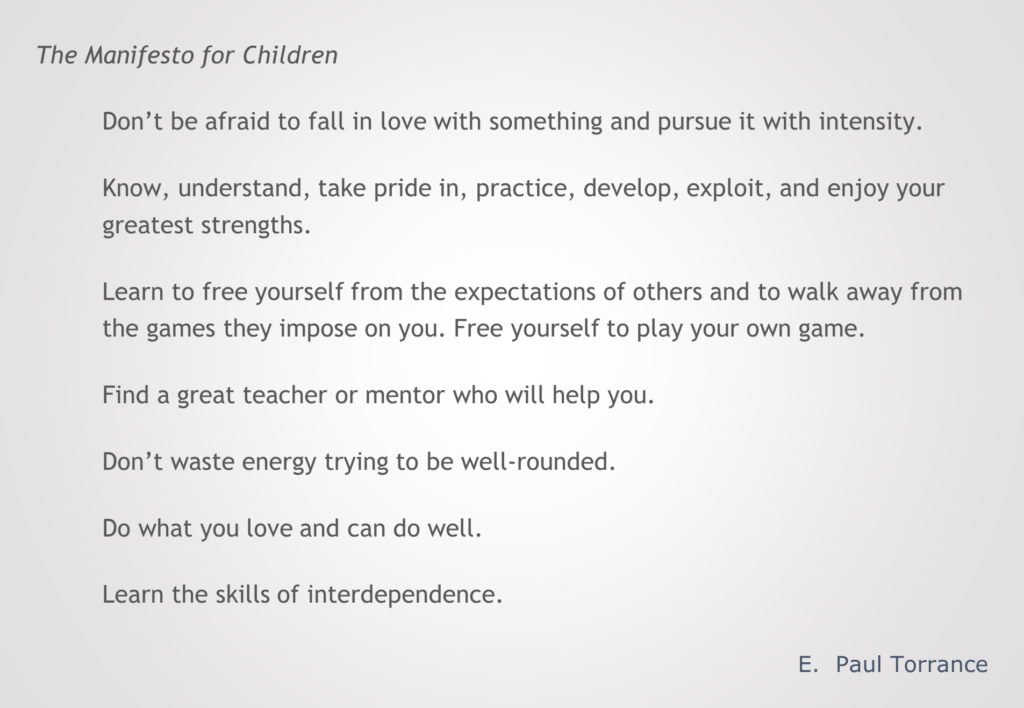
Many of us learn these important ideas later in life, or maybe not at all. Torrance hoped to help improve a creative individuals’ chance of success and life fulfillment with his study and manifesto.
Similarly, you will be most successful and be able to help others more when you focus your time and energy on those things you are good at and passionate about. Big goals take hard work and if you don’t have the knowledge and excitement, you will be much less likely to put in the time and effort required. To narrow down the activities you should be spending your time on, draw the following grid on a piece of paper, and divide your ideas, goals, and activities into these categories:
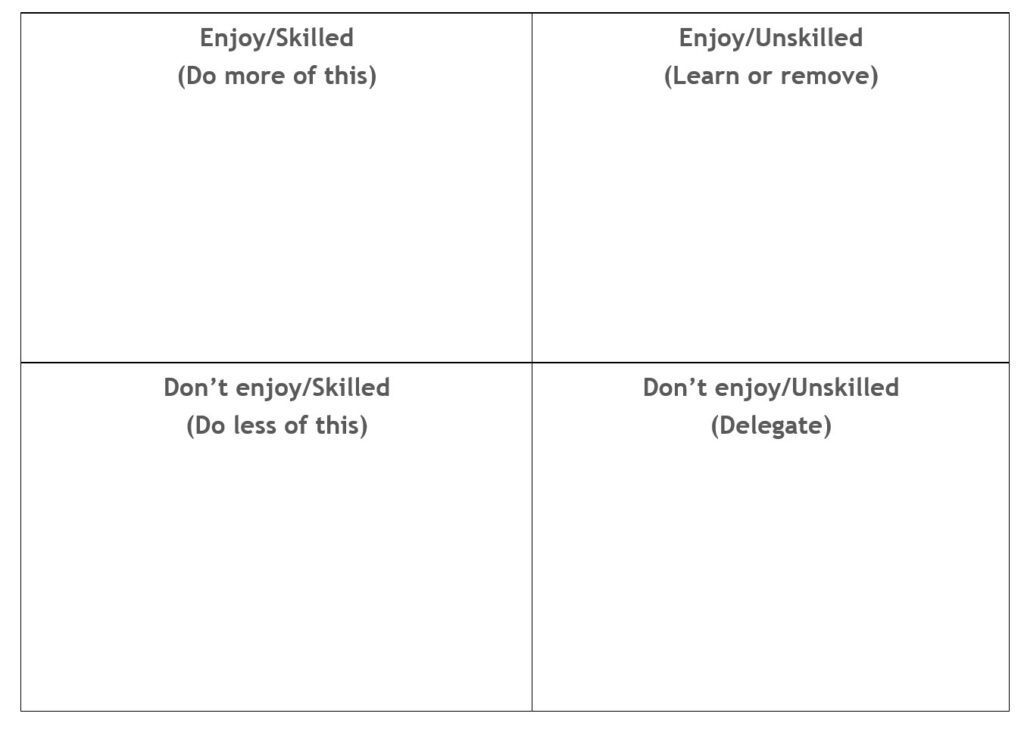
You will want to spend the most time on activities and goals from the top-left “Enjoy/Skilled” quadrant and develop educational or learning goals from the top-right “Enjoy/Unskilled” quadrant. Or, if these activities don’t serve your greater goals, consider removing them. Look at delegating tasks in the bottom half of the grid – those you don’t enjoy – or if possible, remove them. Deleting tasks that don’t serve your greater purpose and goals will open the door for new opportunities.
Determine What To Start, Stop, or Continue Doing
A second exercise that can help you focus on your passions and priorities is the “Start/Stop/Continue” exercise. Write these three words on the top of a piece of paper and list all of those things you would like to start doing, stop doing, and continue doing. If you are a visual person, you might use mind-mapping as a way to brainstorm activities or tasks for each category.
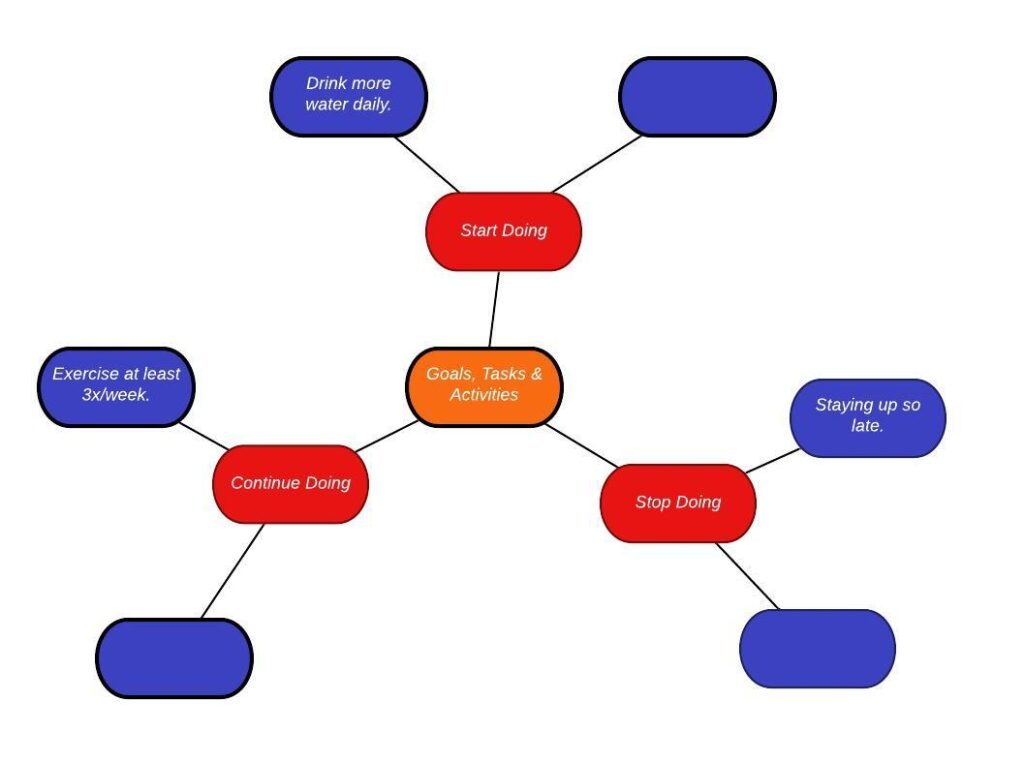
Be realistic when considering your time and energy over the time period considered. This is a great exercise for habit-related activities and goals. For example, in order to have the energy and focus for my big goals, I would like to start drinking more water daily, stop staying up so late, and continue exercising at least 3 days per week.
Find Support and Accountability to Reach Your Goals
Being an entrepreneur, business owner, or leader can be lonely. You want to do great things but may not have someone that understands and shares your passion and drive. Without someone there to communicate your struggles and help get through roadblocks, there may be a loss of momentum or halted progress on your goals. It’s also important to be able to share your excitement when reaching milestones. E. Paul Torrance felt strongly enough about this to include two related items in his Manifesto for Children: “Find a great teacher or mentor who will help you.” and “Learn the skills of interdependence.”
Following are a few different ways you can find this support and assistance:
- An accountability partner. This may be a family member, friend, or colleague, as long as they share your drive and passion and provide the support and encouragement you need through the good and challenging times.
- A mastermind group. The advantage of a formal mastermind group is you have a team of people with different backgrounds, experiences, and skillsets as you work to set and reach your goals. For the best chance of success, I would recommend a paid group with an experienced leader/host.
- A business, life, or productivity coach. Sometimes it makes the most sense to hire a coach to help you get clear on your passions, strengths, and goals and then to help you develop the plan to reach those goals. This person should provide motivation and accountability, be a sounding board as you work through challenges and offer solutions to keep you moving, and be your greatest cheerleader when things go well.
The world needs your big ideas – your book, your product, your new business, your knowledge, your energy, your talent. What will you do to ensure you prioritize, focus, and take action so you can reach your biggest goals?
More blogs related to Priorities, Goal-Setting, and Planning:
Get Unstuck with a Simple Project Plan
Create Your Top 10, and Bottom 10, List
The Superman: Goal Achieved

by Lori Vande Krol | May 21, 2020 | Motivation, Procrastination, Task and Project Management, Time Management
“I have so much to do and I just can’t make myself do anything.” This is what I heard from my teenage daughter last week when I walked into her bedroom. Emma is a junior in high school and was trying to juggle three college placement tests, preparation for two choir auditions, and homework for four classes, all on her own and online due to Covid-19. I immediately put on my “productivity consultant hat” and asked her, “Have you made a list? Did you schedule everything into your bullet journal? Are you focusing on what has to be done this week?” She continued, “I’ve done all the things, mom, but nothing is working.”
Do you ever feel overwhelmed by a lengthy to-do list, and all of it feels of equal importance? Sometimes we can feel so much anxiety by looking at our many to-do’s that we don’t know where to start, and the methods and habits that have worked in the past just aren’t working now. Below I share a couple of quick tips to help you get through the most overwhelming of times.
Choose One Thing to Focus on Right Now
Continuing with the example of my daughter’s stressful situation, I asked her, “Why don’t you choose three things to focus on and forget about the rest? Just work to check those off your list one by one to feel a sense of accomplishment.” I knew that once she got those first three things done, she would feel a little better about moving to the next on her list. After hearing that she had also tried this “trick” and it still didn’t kick-start her motivation, I left her with, “Okay, turn on your relaxing music, chose one thing to do right now, and then we will talk again.”
During the most stressful times, you may need to pare back to the most basic productivity strategy – choose just one thing to focus on right now. Ask yourself, “What is the next action I need to take to move a project or task forward?” Do that and then find the next thing to focus on. Soon you should start to feel a sense of control over your to-do’s, your stress levels will decrease, and you can work to get a better handle on the rest of your list.
Choose Three Things to Focus On Today
Later that morning, Emma explained that she had been thinking about the “choose three things” method and wondered if it hadn’t worked in the past because she didn’t write her goals down – instead, she had just determined in her head what three tasks she would do. I told her I would check in with her via text for the next few days to remind her to write down her three goals and check on her progress. Here was the first day’s response:
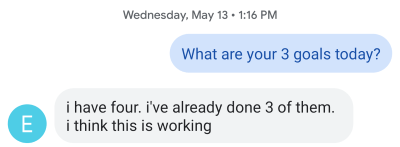
Success! At least for that day. This extra act of writing down her goals added to the intentionality of the actions and was just enough to get her over her productivity hurdle. The next day’s text was answered with a list of her three goals for that day. Emma may not continue this habit every day moving forward. Instead, she will likely go back to her normal method of weekly planning in her bullet journal. But it was what she needed to get through the high stress levels she was encountering at that time.
When to Use This Simple Process for Increased Productivity
As discussed, using the process of choosing three goals each day is a great tool during times of high stress or feelings of extreme overwhelm. This is also a great process to use if you haven’t yet developed a weekly and/or daily planning habit. Begin with a brain dump of all of your to do’s. Get them off your mind and on paper, or in digital form. Prioritize them if you can. Then, each morning choose three goals to focus on that day.
- Each morning, choose three things you will accomplish today.
- Write them down. Consider sharing them with someone.
- Get to work!
What’s Next?
Once you complete your three goals for the day, celebrate, and then choose the next 1-3 actions. Soon you will have more control and a better perspective of your to-do’s. When you are ready to move to the next level of weekly and daily planning, take a look at “What Should I Do Right Now?” for additional planning tips.
If you struggle with goal setting, prioritization, planning, or are just feeling overwhelmed with work and life, please reach out to me or schedule your free 30-minute Productivity Assessment. I would love to help you gain control and develop the habits that save you time, energy, and stress.

by Lori Vande Krol | Mar 24, 2020 | Email, Goals and Priorities, Organization, Task and Project Management, Technology, Time Management, Tools
The past several weeks with the coronavirus pandemic have been unprecedented. We are in an environment of fear, stress, uneasiness, and unknowns. While it will take time for us to work through these emotions, it is important that we also try to continue as normal in ways that we can control. Productivity expert Barbara Hemphill said, “Control the things you can, so you can cope with the things you can’t.” I think this is true now more than ever.
19 Productive Actions You Can Control
One byproduct of social distancing is that many of us have found ourselves with unexpected time on our hands – closings, canceled events and appointments, reduction in travel time on planes, trains, and cars, and for some, an unfortunate reduction in customers or client work. Why not utilize this time for tasks or projects you have been putting off or just haven’t had the time to address? Take some control by working on things that will strengthen and grow your business, your career, and/or yourself, and create a solid base for “after the virus.”
Below I share a list of 19 productive actions you can take now, along with tips, resources, and recommended tools to assist with the task. Don’t be overwhelmed by the length of the list. Instead, choose a few of the highest priority items for you and/or your business and focus on taking action on those first.
At the end of the article, I provide a free download that will allow you to more easily prioritize each item and track your progress.
Disclaimer: Life Made Simple sometimes partners or affiliates with companies providing products, applications, or services that we feel would benefit our clients. In these cases, we may receive a small commission on sales through our affiliate links.
Organize Your Office Space and Information
1. Organize your office space
Whether you have a room devoted to work or space within another room, a clear, organized area can help improve focus and productivity. Clear off your floor, desk, and other surface areas. Toss, recycle, shred, or donate any unneeded items. Leave out only those items that add to your productivity, peace, or joy.
2. Clean out and organize your paper files
Divide your files into action (items you are working on now) and reference (items you are keeping for tax/legal reasons or future reference). Label files alphabetically (e.g. client files) or topically. If you have more than one file drawer full of paper, consider numerical labels and an online inventory of your paper files using the Paper Tiger filing system.
3. Set up a daily and/or monthly action file system
An action file system such as this one by Smead allows you to file papers or cards by day and/or month as reminders to complete a task or to be easy accessible when you need them. Keep the file system in a desktop file
allows you to file papers or cards by day and/or month as reminders to complete a task or to be easy accessible when you need them. Keep the file system in a desktop file along with a few hanging files to hold quick reference papers.
along with a few hanging files to hold quick reference papers.
4. Declutter and organize your digital files
Depending on your current structure and content, decluttering and organizing digital files can mean something different for everyone. Start with this checklist of things to think about when attacking your digital world and then develop your unique plan.
5. Set up your email for productivity
Like digital file management, email management can differ depending on the application you use (e.g. Outlook or Gmail), how much email you receive daily, and whether you use your email app for other productivity tasks such as calendar, tasks, and contacts. Check out this past blog post to help you get started with The Only 5 Email Folders You Really Need.
6. Go paperless
Moving towards a paperless environment requires a good scanner. My favorite scanner for moving those piles of paper, notes, and business cards to digital form is the Fujitsu ScanSnap. It is the most expensive tool of all of the resources mentioned here, but well worth the cost if you work with a lot of paper, want to be more digital, and/or often work remotely.
7. Manage your contacts
Whether this means scanning or entering business card information, cleaning out old contacts and updating current ones (I use the Duplicate Contacts app for Android and Apple phones – there are many others!), or setting up a full-blown CRM (customer relationship management) system, contact management is a great way to spend some unexpected downtime.
Get Clear on Your Goals
8. Determine your rocks (what is most important)
If it has been a while since you really stepped back to evaluate what is important to you in business and life, this is a great time to get re-centered and focused on what matters most. I am happy to share an exercise I use with individuals and groups for this reason.
9. Develop your 2020 goals
Once you know your “rocks,” you can work to develop your goals for the remainder of the year. I am confident life will get back to normal and when it does, what will you focus on for the remainder of the year? It’s okay if your goals aren’t perfect right now. Just get something on paper and then reevaluate once the pandemic has passed.
Analyze and Manage Your Time
10. Analyze your time management habits
When it comes to time management, have you ever wondered where you excel? And where you could improve? Spend some time looking at your strengths and weaknesses and make a plan for continuous improvement. If you’d like help with this reflection and/or putting systems in place to better manage your time, please contact me. I’d love to help!
11. Start using a daily time management tool
Now may also be the perfect time to review a few different time management tools to see what might work best once we get back to our hectic lives. Of course, my favorite is the ProAction Planner. [Update: Check out this article from Well + Good listing the top planners for 2025.]
Practice Risk Management
12. Back up your files
You have many options for backing up files, photos, email, and other digital information:
13. Evaluate your financial position
For businesses, utilize your current financial tool to review your actual results versus goals to date in 2020. How will this downtime impact your goals, if at all? If you are not using a financial tool, consider implementing one. Quickbooks, Freshbooks, and Xero are popular options. (Before introducing a tool such as these, be sure to do a technology needs assessment to ensure you are choosing the right tool for your needs. Last month’s blog shares a list of things to consider when analyzing a new or improved technology tool.)
Individuals should also review the impact of the pandemic on their financial position and develop a resulting budget and plan for the rest of the year.
Work on Yourself
14. Learn or fine-tune a skill
Skillshare, is a great resource for videos and training resources for a variety of skills. And, the first 2 months are free! A quick search on YouTube or Google will provide many more options.
15. Read a book
While I’m sure you have your own list of “must-read books,” a few non-fiction books I recommend (depending on your need and interests) are:
Building a StoryBrand: Clarify Your Message So Customers Will Listen
Atomic Habits: An Easy & Proven Way to Build Good Habits & Break Bad Ones
Unstoppable: A 90-Day Plan to Biohack Your Mind and Body for Success
I have a long list of recommended fiction books as well. Let me know if you are interested, or share your favorites in the comments below.
16. Get/stay healthy (exercise, meditation, healthy eating)
Getting and/or staying healthy when stuck at home takes a little bit of work. Since my normal workout location is closed, I joined an on-demand site with videos of the classes I normally take and purchased an inexpensive weight set on Amazon.com. Many workout locations and online exercise sites are providing free challenges, workouts, and videos. In addition, you can find several meditation, yoga, and recipe or meal apps in your phone’s app store.
17. Spring clean your home
Okay, I know this isn’t really “working on yourself” but It is a great way to feel better about yourself and your environment, and a clean, clutter-free home can help you feel more productive in your home office. Here are a few Spring Cleaning Checklists to track your progress. I chose to use the third as I felt it was the most inclusive and I liked that it gave me space to add my own tasks.
The Happier Homemaker
Freebie Finding Mom
Imperfect Homemaking
Give Back
18. Send cards, texts, or emails
Make someone feel a little less lonely or just make someone smile with a note of thanks or encouragement.
19. Help others
Giving can be financial, but doesn’t have to be. Drop off needed supplies or other physical donations, safely volunteer your time if you are healthy and able, or donate blood. You might also share your expertise or knowledge to help others in areas of need during this time, as is my hope with this blog. Buzzfeed and PBS share lists of other ways to help during the pandemic. And this article from Bankrate provides a unique idea – giving back utilizing your credit card rewards points.
Free Downloadable Checklist
I realize this is a long list! Not every item will apply or be important to every reader. In order to prioritize and track your unique action list, I am providing a free, downloadable checklist below. Be sure to refer back to this blog for the supporting resource links.
If you are in need of assistance, coaching, or support related to any of these tasks, please reach out via my contact page or by scheduling your free 30 minute productivity assessment. All of my work can be done virtually via phone or video call.
I wish all of you health, safety, love, and peace over the coming weeks and months. Spend time with family, call your friends, give back, focus on you, and control what you can.

by Lori Vande Krol | Feb 17, 2020 | Task and Project Management, Team Productivity, Technology
Unless you completely avoid politics and social media, you have no doubt heard about the “caucus chaos” that recently occurred right outside my door in Iowa. Much of the media has blamed the chaos on a new smartphone app the Iowa Democratic Party implemented to help get results more quickly. Because I have a large interest in the successful selection and implementation of technology, I thought I’d dig into it a bit further. What happened in Iowa is just one very publicized example of what happens daily in companies and organizations that do not take the time to properly analyze their vision and needs when choosing a new technology tool, or to carefully plan for a successful implementation of the chosen system. How could this have been avoided?
What Went Wrong with the Iowa Caucus?
It is true that much of the cause for reporting delays and questions about count accuracy was due to a “coding error” in the Shadow smartphone application that was used by the Iowa Democratic Party (IDP) to report caucus voting results. The error resulted in only partial results being reported. But if you look just a little deeper, there were more underlying issues that can’t be blamed solely on the creator of the application.
Following are additional factors leading to the issues with the Iowa Caucus:
- State campaign finance records show the IDP paid Shadow, the tech company that created the app used in Iowa, more than $60,000 for “website development” towards the end of 2019. Shadow (or what I’ve also seen called the Iowa Reporter App) was a new app, reported to be just 5 months old, and created specifically for reporting of caucus results. This is not enough time to have been developed and fully tested before being rolled out for such a large and public endeavor.
- Once the IDP had the app, there was not enough time for users to learn and test it themselves. In fact, some users weren’t even able to get past the log-in screen.
- This year, a new set of reporting requirements was put in place by the Democratic National Committee. Historically, precincts would only announce the outcome in terms of state delegate equivalents (S.D.E.s). In 2020, precincts were required to report three numbers per candidate: (1) raw vote totals, (the initial alignment), (2) the totals after the shifts of participants from non-viable candidates (the second alignment) and (3) the estimated delegate count for each candidate. While this may be confusing for those not involved with caucus procedure, it isn’t difficult to reason that this increase in requirements, along with the use of a new application, and short time frame for development, training and testing, was the start of “the perfect storm.”
- In addition to the Shadow app, it was reported that there were training issues with other programs needed for efficient reporting of results, including Google Sheets, and problems with 2-factor authorization needed to access those programs.
- The back-up process for reporting results when the app did not work was to call headquarters and manually report results (which is the way it had been done in past years). But, there were not enough lines and/or people to answer these calls and volunteers were left waiting for hours. It was quite obvious the back-up plan hadn’t been fully thought through.
It is my guess that there were more issues involved in the selection and implementation of caucus reporting systems and processes this year. Iowa Democratic Party Chairman, Troy Price, has called for an independent forensic review of the decisions and processes (or lack of processes) that led to the failure. I look forward to learning more from that review.
2020 Iowa Caucus Consequences
What we do know is that there has been some pretty large consequences of the lack of proper analysis, testing, and implementation.
- Chairman Price has resigned as chair of the party after 2.5 years of service, effective as soon as a replacement is elected.
- The Nevada Democratic Party, who had planned to use Shadow, has now dropped the vendor.
- The Democratic National Committee Chair, Tom Perez, along with the Bernie Sanders campaign, have asked for a “recanvassing” check of votes.
- Thousands of extra volunteer and paid hours were needed to report the initial results and will be needed to assist with the recanvassing as well as the independent forensic review.
- The negative PR for the Iowa Democratic Party and the state of Iowa will likely result in Iowa losing its status as the first caucus state in the country, with a large impact to hotels, restaurants and other local vendors that benefited from the event. It is not unreasonable to assume this misstep has costed the IDP and the State of Iowa hundreds of thousands of dollars.
How the Caucus Chaos Could Have Been Prevented

The chaos that occurred in Iowa could have been fairly easily prevented. Following are the key components of successful technology assessment and implementation, and what may have been missing from the Iowa Caucus process:
Understand Your Need and Create a Vision for Success
What is driving the desire or need for the new system or tool? Are you solving an issue, creating efficiencies, or enhancing a process in another way? What will success look like? What will you be able to do that you cannot do now?
What was missing? While we won’t know for sure until after the independent review, I have to wonder if the IDP did what I see many other companies do…they go for the newest shiny object without truly analyzing the need and how the tool might fulfill it. Was it necessary to change the current system for caucus counting and reporting? What was the specific issue that needed to be addressed? If there was a challenge in the current process, or the IDP wanted to save time and create efficiencies by using an automated app, was a vision defined? How did they see a new tool working and what would success look like? They could then choose a tool to best fit that vision for success. Perhaps the IDP did spend some time on this component and was clear in their need and vision but faltered in a later step.
Implement a Needs Analysis
A formal Needs Analysis takes the component above – understanding need and vision – several steps further in that it provides a process for decision makers to gather information needed to select the optimal technology. The Needs Analysis will address:
- resources available and new resources needed to implement and maintain the tool, including human and financial resources, and timeline;
- any obstacles that could get in the way of implementation or maintenance of the tools;
- level of comfort with technology, leading to a better understanding of training needs;
- features needed, which can be gathered in a format such as “must have”, “nice to have”, and “not needed.”
What was missing? Did the IDP take the time to evaluate all of these steps prior to asking Shadow to develop the app for them? They may have been clear on their budget and the needed features, but it is clear that not enough time was spent discussing obstacles that could prevent effective implementation (such as the app not working when it is needed most!), training needs due to many users not having a high level of comfort with technology, and the impact of an unreasonable timeline for development, testing, and training. This could have all been addressed with an appropriate Needs Analysis.
Match the Need with the Technology
Once the Needs Analysis has been completed, it becomes much easier to match the appropriate technology tool with the need. There are many great resources to find and evaluate applications but what is most important is to find the tool that best matches the results of the Needs Analysis and to evaluate the strength, security, and longevity of the application’s creator and/or owner.
What was missing? Without the appropriate Needs Analysis, it was impossible for the IDP to know whether they were choosing the most optimal system. Based on a February 4, 2020 article from The Atlantic, there is evidence that this was a situation in which leaders in the IDP knew some of the leaders in Shadow’s company and that appeared to be enough to move forward with their application.
Develop the Project Plan
Once the optimal technology is chosen, it is time to develop a plan for successful implementation. There is too much involved with project planning to cover here (refer to Get Unstuck With a Simple Project Plan for project planning tips), but the importance of creating and following a technology implementation plan cannot be stressed enough.
What was missing? What wasn’t missing? I believe that due to the tight time frame involved, the IDP had no time to develop or carry out a successful project plan. Just a few of the pieces missing were: (1) time for testing the application, (2) training of all users, and (3) creation of backup plans for multiple situations.
Take a Holistic View of Technology
A holistic view of technology means looking at all of the systems currently used by an organization and determining how new technology will coordinate and compliment those systems. This is important for an efficient implementation of the new technology as well as continued effective use and maintenance.
What was missing? While I am not aware of all of the systems utilized by the IDP, one main obstacle that was not addressed was how to coordinate the use of the new application with those precincts that desired or needed to continue to use the old, manual method of reporting. It has been reported that the IDP assumed all volunteers would download the app with no issues, even though some did not receive instructions to do so until 2 days before the caucus. Staffing and technology needed to take the manual calls was not sufficient. Additionally, there was the issue with 2-factor authorization that was discussed earlier. Cell phones were not allowed in counting rooms, but 2-factor authorization within the technology required volunteers to have their cell phones to receive the security code. Understanding how the technology would need to coordinate with the use of cell phones was vital here.
What Have We Learned from the Iowa Caucus Chaos?
While the Iowa Caucus gaffe was certainly unfortunate and impactful, how many can say they have never been involved with an organization that has not made a similar mistake – rushing through decisions, not completing a thorough needs analysis, or not developing and following a project plan? In my work as a productivity consultant, I often find during new client discovery sessions that some of their productivity challenges are caused by the mistakes made in technology selection and/or implementation. Organizations ranging from Fortune 500 corporations to very small businesses struggle every day with the results of poor planning and decision-making resulting in thousands of hours and millions of dollars lost and frustrated management and employees. Additional time and money are then spent to clean up the mess and redo the process the right way.
Hopefully some good can come from the Iowa Democratic Party’s mistake, that is a larger awareness of the importance of following the steps for successful technology implementation. While it will take more time and effort upfront, we have learned that the consequences of not doing so can be much greater.










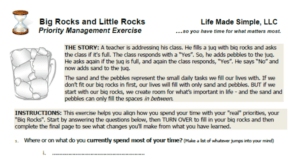
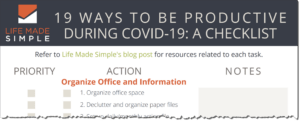


Recent Comments